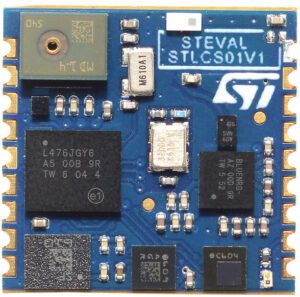After reading “Developing a Wearable Internet of Things (IoT) Platform for Gait Classification” two questions come to mind: is there a better way to teach electronics engineering, and should we start earlier? The fascinating paper was written by Kavin Balakrishnan, Arunan Elamaran, Michael Davydov, Ryan Tabrizi, and Keshav Vyas after they took the course “E96C: Internet of Things” at UCLA during the summer of 2020. The students were still in or just out of high school when they attended the class remotely during a global pandemic. Yet, they created a gait classification system with an STEVAL-STLKT01V1 SensorTile kit and a Nucleo board strapped to a person’s waist.

The gait classification project
How it started

At the core of E96C is Professor William Kaiser, whom readers of the blog know as the author of the SensorTile curriculum. He’s also behind a course on motor control and control systems that uses the STEVAL-EDUKIT01 pendulum. Strengthened by his experience, Professor Kaiser used the SensorTile to teach E96C. The course had no computing requirements. Yet, despite little to no background in embedded systems, students learned how to capture data, create algorithms, and use machine learning on an STM32 to write a gait classification application. In the paper by Balakrishnan, Elamaran, Davydov, Tabrizi, and Vyas, the system recognizes a normal walk and climbing up or down a flight of stairs.
How it’s going
The gait classification project first relied on SensorTile’s gyroscope and accelerometer to capture training data. It enabled the students to experiment with sample rates and taught them to obtain quality results. They then used MATLAB to analyze the information and find patterns. Afterward, the authors determined that using a dynamic decision tree rather than a neural network would offer the best efficiency and accuracy. The conclusion led them to write the algorithm, which had more than 90% accuracy when the user’s movements were smooth. Accuracy dropped to 75% with erratic gestures.
The Challenge of keeping students in engineering programs
50% drop out
Beyond the technology it describes, could this paper serve as a way to start a discussion around engineering education? In an article published in the International Journal of Engineering Education1, Geisinger and Raman posit that “half of the students entering engineering degree programs in the U.S. leave prior to graduation.” The researchers then reviewed the literature to find the causes and potential solutions. Among the explanations for this phenomenon, poor high school preparation and inadequate classroom teaching ranked high. Many also admitted lacking a “sense of engagement or belonging.”
A hands-on solution with a SensorTile
Interestingly, the paper by Geisinger and Raman lists “hands-on design projects” as one of the remedies to student attrition, and the gait classification project from the students that attended E96C seems to corroborate that conclusion. The former high school students that took E96C and worked on the SensorTile project are all pursuing engineering majors. They also explained that the course familiarized them with embedded systems, microcontrollers, sensors, machine learning, MATLAB, C programming, IDEs commonly used in the industry, and more. While research shows that proper high school preparation is critical for success in an engineering college program, the SensorTile curriculum and E96C demonstrate how teachers can make a difference before students graduate high school.
The challenge of shaping students for the workplace or graduate programs

Gait classification is a complex computing problem because each person has unique patterns. For instance, a person’s walk is shaped by more than 20 characteristics, all of which will form the gait. Precise classification thus requires tracking a myriad of specificities and learning how they apply to a particular individual. It is, therefore, no wonder that gait remains a trendy research field. Entering “gait analysis” in Google Scholar yields more than 5,000 papers in 2022 alone, with many looking at sensors and machine learning to solve the classification challenge. Academically, this topic provides an exciting approach to the end-to-end development of algorithms, an introduction to Arm architecture, and exposure to prototyping.
Therefore, the paper from the former E96C students is a testament to a curriculum’s ability to impart practical problem-solving skills to design solutions for today’s major problems. By writing a gait classification program and running it on an STM32 MCU and a SensorTile kit, Balakrishnan, Elamaran, Davydov, Tabrizi, and Vyas went from being students to working as designers. They demonstrated skills that would positively influence their marketability or acceptance to a graduate program, both influential components in the ranking of universities and colleges. Coursework like the Internet of Things and Embedded Machine Learning curriculum that rely on hardware like the ST Nucleo board and shield thus have an impact that expands far beyond the classroom or the semester.
- Read Developing a Wearable Internet of Things (IoT) Platform for Gait Classification
- Download the project’s source code on GitHub
- Grab a SensorTile kit
- Geisinger, Brandi & Raman, Dave. “Why They Leave: Understanding Student Attrition from Engineering Majors”. International Journal of Engineering Education. 2013. Volume 29. 914-925. ↩




